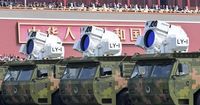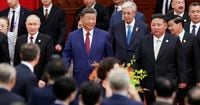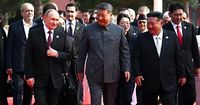On September 3, 2025, Beijing’s iconic Tiananmen Square transformed into a dramatic stage for one of the most elaborate military parades China has ever mounted, marking the 80th anniversary of the end of World War II. The event, attended by an estimated 50,000 spectators, was a display of not only military might but also of political symbolism, with Chinese leader Xi Jinping welcoming a roster of world leaders including Russian President Vladimir Putin, North Korean leader Kim Jong Un, and Iranian President Masoud Pezeshkian. The spectacle underscored China’s ambitions to assert its growing influence on the global stage, while also signaling a realignment of international relationships that could reshape the world order.
President Xi Jinping, standing at Tiananmen Gate flanked by Putin and Kim, opened the 90-minute event with a stirring tribute to Chinese veterans of the Second World War. "The Chinese people are ... not afraid of violence and are self-reliant and strong," he declared, according to the Associated Press. Xi’s speech, without directly naming the United States, emphasized the importance of safeguarding China’s sovereignty and unification—a pointed reference to the self-governed island of Taiwan, which Beijing claims as its own. "The Chinese people’s rejuvenation cannot be blocked, and the noble goal of the peaceful development of human civilization must triumph," Xi concluded, as reported by AP.
The parade itself was a technological showcase, revealing to the world a new generation of weaponry. According to BBC News, China debuted the LY-1 laser weapon, mounted on armored trucks, believed to have the capacity to disable electronics or even blind pilots. The AJX002 submarine drone, a 65-foot-long unmanned underwater vehicle, was another highlight; experts say it could be deployed for reconnaissance or surveillance missions. Stealth attack drones like the GJ-11, capable of flying alongside manned fighter jets, made their first public appearance, as did four-legged robotic "wolves"—machines designed for mine-sweeping, reconnaissance, or even hunting down enemy troops.
Perhaps most significant was the unveiling of new long-range, nuclear-capable missiles. The DF-5C intercontinental ballistic missile, described by defense analyst Alexander Neill to the BBC as having a range of 12,400 miles and the ability to carry up to 12 warheads, was rolled out for the first time. The DF-61, a mobile-launcher missile, and the JL-1 and JL-3 missiles—capable of being launched from aircraft and sea vessels, respectively—were also displayed, signaling China’s intent to modernize and expand its nuclear deterrent. As Michael Raska, another defense analyst, told BBC News, "China not only wants to augment, but replace traditional structures," integrating artificial intelligence and lessons from recent conflicts, such as Russia’s war in Ukraine, into its strategic doctrine.
The parade was more than a military pageant; it was a diplomatic summit. For the first time, Xi, Putin, and Kim appeared together at a public event, sending a message of unity in opposition to the US-led global order. As DW reported, Xi used the occasion to position himself at the center of a "new constellation of power." The presence of Kim Jong Un’s daughter, believed to be named Ju Ae, marked her international debut and added a further layer of intrigue to the North Korean succession narrative.
Putin and Kim’s rapport was on full display, with the two leaders traveling together to formal talks after the parade. Russian state media reported Kim’s pledge of "full support" to Putin, promising to do "everything I can to assist" Russia’s war in Ukraine. "On behalf of the Russian people, I would like to thank you for your participation in the joint fight," Putin told Kim, as quoted by TASS. The Kremlin later released footage of Putin inviting Kim to visit Russia, to which Kim replied, "See you soon." According to DW, South Korean intelligence has reported that about 2,000 North Korean soldiers have died fighting for Russia in Ukraine, underscoring the depth of their military cooperation.
The gathering drew sharp criticism from Western officials. EU foreign policy chief Kaja Kallas described the event as an "autocratic alliance" and a "direct challenge to the international system built on rules," as reported by DW. She argued that Russia’s war in Ukraine is being "sustained by Chinese support," and warned that the optics of Xi, Putin, and Kim standing together were more than just symbolic. Philippine Defense Secretary Gilberto Teodoro also condemned the trio’s appearance, calling it "intimidation" and "a threat especially to smaller nations," AP reported.
Former US President Donald Trump, never one to shy away from pointed commentary, took to social media as the parade unfolded. "Please give my warmest regards to Vladimir Putin, and Kim Jong Un, as you conspire against The United States of America," he wrote on Truth Social. Trump’s remarks reflected the wary eye with which the US viewed the gathering, especially in light of a recent summit in China that brought together Xi, Putin, and Indian Prime Minister Narendra Modi.
The parade’s opening was as grand as its guest list. An 80-gun artillery salute echoed across the square, followed by a performance of the national anthem and the "March of the Volunteers," a song composed in 1935 during China’s resistance against Japanese invasion. Troops marched in perfect lockstep, their boots resonating off the pavement as Xi reviewed their ranks from a classic black limousine, standing through the sunroof to greet the assembled soldiers. Fighter jets and bombers soared overhead, painting colored trails in the sky, while helicopters flew in formation to spell out "80"—a nod to the anniversary year.
Yet, amid the grandeur, tensions simmered. Across the Taiwan Strait, President William Lai used the occasion to remind the world of Taiwan’s commitment to peace and democracy. "Taiwan does not use the barrel of a gun to commemorate peace," Lai wrote on Facebook. "Instead, it recalls the martyrs, remembers the lessons of history, and upholds the belief in freedom and democracy." Lai also criticized "strongman leaders" and personality cults, implicitly rebuking Beijing’s approach, according to DW.
For many observers, the parade was a carefully orchestrated signal—a demonstration of China’s technological prowess, a rewriting of historical narratives to stoke nationalism at home, and a declaration that the balance of power is shifting. As BBC News noted, while China’s arsenal is growing, questions remain about its operational agility compared to the US military’s "bottom-up" culture. "The Chinese think it’s technology that creates deterrence... but at the operational level, there have been instances which show they may not be as good as they say they are," Raska told the BBC.
As the world watched Beijing’s show of strength, the message was clear: China is ready to play a leading role in shaping the future of global security. Whether that future is defined by peace or confrontation remains to be seen, but the reverberations from Tiananmen Square are certain to echo far beyond its granite stones.



